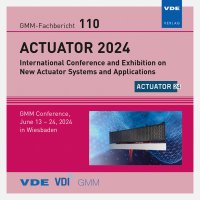Self-sensing in spring-loaded SMA actuators using artificial neural networks
Conference: ACTUATOR 2024 - International Conference and Exhibition on New Actuator Systems and Applications
06/13/2024 - 06/14/2024 at Wiesbaden, Germany
Proceedings: GMM-Fb. 110: ACTUATOR 2024
Pages: 4Language: englishTyp: PDF
Authors:
Koshiya, Krunal; Naumov, Vladimir; Gorges, Tom; Rizzello, Gianluca; Motzki, Paul
Abstract:
When shape memory alloy (SMA) wires are heated above their austenite finish transformation temperature, their length reduces because of a phase transformation from martensite to austenite. Consequently, the electrical resistance of the SMA changes depending on the wire length, its cross-section area, as well as the material temperature and austenite/martensite phase composition. Based on this fact, changes in SMA resistance can be correlated to the wire strain, opening up the possibility of self-sensing in SMA-actuated systems. To effectively achieve self-sensing, it is important to model the correlation between the actuator electrical resistance and the corresponding mechanical strain. Such a correlation, however, is affected by various factors like biasing mechanism, amplitude of force acting against the wire, actuation frequency, and electrical activation strategy for heating the SMA wire. Moreover, the resistance-strain curve may exhibit a non-monotonic and hysteretic behavior, which makes its inver-sion practically hard to achieve. In this paper, we present an artificial neural network-based approach to model the electromechanical characteristics of a spring-loaded SMA wire actuator. Data is collected via a custom-developed experimental test rig. Different types of neural network architectures are implemented on a microcontroller, capable of predicting the displacement achieved by an SMA actuator based on electrical signals measurements. The self-sensing predictions are finally validated against a displacement laser sensor, to assess the accuracy of the proposed approach.


